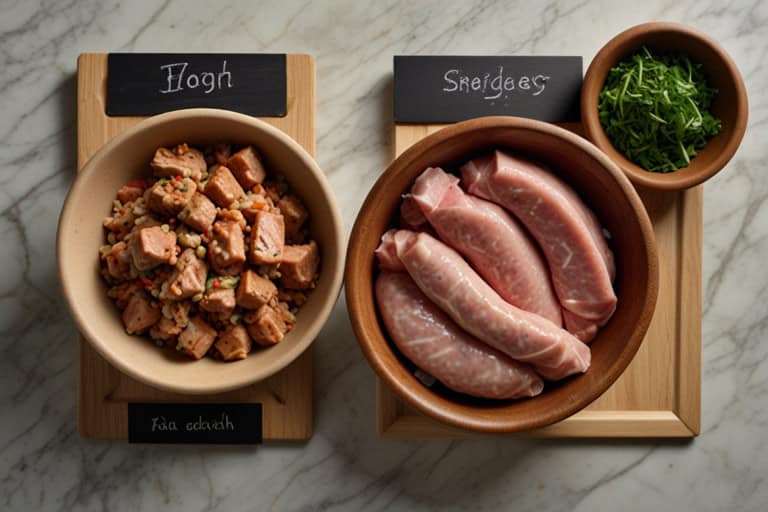Chicken sausage is seasoned, processed, and often contains added fats, sodium, or preservatives. Ground chicken is unseasoned, minimally processed minced meat, offering lean protein. Nutritionally, sausage tends to be higher in calories and sodium; ground chicken is lower in both but requires seasoning for flavor.
Cooking methods vary: sausage is pre-seasoned for grilling or pan-frying, while ground chicken adapts to dishes like tacos, meatballs, or stir-fries. Choose sausage for bold flavors and convenience; opt for ground chicken for versatility and control over ingredients. Keep reading to explore which suits your dietary needs and recipes best!
Key Takeaway
- Chicken sausage is seasoned and often contains fillers, while ground chicken is just minced meat.
- Ground chicken is typically lower in calories and fat, making it a healthier option for many.
- Both have versatile uses in cooking, but they cater to different flavor preferences and dietary choices.
Preparation and Composition

Credit : Bobby Parrish
Chicken sausage blends ground chicken with spices (like garlic, paprika, or herbs), salt, and often fillers such as added fats, grains, or other meats to enhance juiciness and texture. This mixture is encased in casings, creating its signature shape. The seasoning makes it flavorful and convenient, but it’s higher in sodium and calories due to processing. Ideal for quick meals like grilled links or skillet dishes, it delivers bold taste with minimal prep.
Ground chicken is simply minced meat—typically a blend of white and dark meat for balanced moisture and flavor. Unseasoned and minimally processed, it’s a lean, versatile protein blank slate. Use it in tacos, meatballs, or stir-fries, tailoring spices to your preference (e.g., Italian herbs, curry, or chili). Nutritionally, it’s lower in sodium and calories than sausage but requires added flavor.
Key Differences
– Chicken Sausage: Pre-seasoned, higher in sodium/fat, convenient for bold flavors.
– Ground Chicken: Neutral base, adaptable to recipes, better for calorie-conscious meals.
Choose sausage for quick, savory dishes or ground chicken for customizable, healthier options. Both shine in diverse recipes—experiment to find your fit!
Nutritional Comparison

Ground Chicken vs. Chicken Sausage: Nutritional Breakdown
- Ground chicken (100g = ~189 calories) is leaner, with less fat and sodium, making it ideal for weight management. It’s rich in protein (supporting muscle growth), B vitamins (energy metabolism), zinc (immunity), and iron (blood health). A versatile blank slate, it thrives in tacos, stir-fries, or meatballs when seasoned creatively.
- Chicken sausage (100g = ~324 calories) packs bold flavor from spices and fillers but is higher in calories, sodium, and saturated fats. While it provides protein, its processed nature and salt content may deter health-conscious eaters. Best enjoyed grilled or in pasta dishes in moderation. (1)
Key Nutritional Differences– Calories: Ground chicken (189) vs. sausage (324). – Fat: Ground chicken = lower; sausage = added fats. – Sodium: Sausage often doubles ground chicken’s salt content. – Protein: Both are solid sources, but ground chicken edges ahead. Cooking Tips
- – Ground chicken: Boost flavor with herbs, spices, or low-sodium sauces.
- – Sausage: Pair with veggies or whole grains to balance calories.
- – Mix both: Blend for flavor without overloading calories.
Choose ground chicken for nutrient density and flexibility; opt for sausage as an occasional flavor boost.
Culinary Uses
Chicken sausage and ground chicken are two ingredients that can really make meals exciting. They both have unique flavors and can be used in many different ways. For example, chicken sausage is perfect for breakfast or dinner. Ground chicken, on the other hand, is great for all sorts of dishes. (2)
Chicken Sausage: A Flavorful Choice
Chicken sausage is often a favorite for breakfast. It can be served with eggs or mixed into a yummy breakfast burrito. It has a nice seasoning that makes it tasty without needing extra spices.Cooking chicken sausage is simple. It can be grilled, baked, or air-fried. Each method keeps the sausage juicy and full of flavor. Grilling adds a nice char, while baking is easy and quick. Air frying is a fun way to make it crispy without much oil.Here are some fun ideas for chicken sausage:
- Breakfast Sandwich: Put a sausage patty on a bun with some cheese and a fried egg.
- Pasta Dishes: Slice it up and toss it in with spaghetti and sauce.
- Grilled Recipes: Skewer it with veggies for a tasty meal on the grill.
Chicken sausage makes meals fun and flavorful!
Ground Chicken: A Versatile Ingredient
Ground chicken is super flexible. It can fit into many types of meals. Tacos, meatballs, and stir-fries are just a few options. The best part? Cooks can easily change the spices to match their tastes.When using ground chicken, it can be poached or sautéed. Poaching is a gentle way to cook it in simmering water, making it soft and juicy. Sautéing is quick and helps to get a nice brown color.Here’s how to use ground chicken:
- Tacos: Season with taco spices and fill soft or hard shells.
- Meatballs: Mix with breadcrumbs and herbs for a tasty treat.
- Stir-fry: Cook with veggies and sauce for a quick meal.
Ground chicken is not just for one dish; it can be part of many meals!
Chicken Sausage and Ground Chicken Recipes
Here are some easy recipes to try with chicken sausage and ground chicken:
- Chicken Sausage and Veggie Skewers
- Cut chicken sausage and veggies into chunks.
- Thread them onto skewers.
- Grill until everything is cooked and slightly charred.
- Ground Chicken Tacos
- Cook ground chicken in a pan with taco seasoning.
- Serve in taco shells with toppings like lettuce and cheese.
- Chicken Sausage Pasta
- Cook pasta and set aside.
- In a pan, cook sliced chicken sausage until browned.
- Mix with pasta and your favorite sauce.
These simple recipes show just how easy it is to enjoy chicken sausage and ground chicken. They can add new flavors to everyday meals.
Practical Advice for Cooking
When cooking with chicken sausage and ground chicken, it’s good to keep things simple. Always remember to wash your hands before and after handling raw chicken.Using fresh ingredients can make a big difference in taste. Try to add colorful veggies to your meals for extra nutrition.Don’t be afraid to try new things! Cooking is all about experimenting. Adding different spices or sauces can lead to delicious surprises.Chicken sausage and ground chicken are not just tasty; they can also help make cooking fun. Enjoy the process and have fun with flavors!
Flavor Profiles and Seasonings
Different Flavors of Chicken Sausage
Chicken sausage can be made in so many ways. If someone likes spicy food, they might choose a sausage with chili or pepper. There are also mild ones that taste great with herbs like parsley or thyme. It’s like a flavor adventure! Some people may not know that smoked chicken sausage can give a unique taste too.When making chicken sausage, it’s fun to think about what flavors work well together. Using garlic and onion can add a nice depth, while lemon zest can brighten up the dish. It’s good to remember that everyone’s taste is different. What one person loves might not be another’s favorite. Trying different combinations can make cooking exciting and new.
Seasonings to Try
When it comes to seasonings, the choices are endless! Cooks can use things like:
- Poultry seasoning: This mix usually has sage, thyme, and marjoram. It brings a classic flavor to the dish.
- Olive oil: A drizzle can make the sausage juicy and tasty.
- Cinnamon: This spice might sound odd, but a little can add a warm touch that surprises people.
Mixing these ingredients can create something special. For example, adding a bit of garlic powder or even red pepper flakes can change the whole dish. It’s all about what flavors you enjoy!
Making It Your Own
Ground chicken is super versatile. Cooks can create their own unique sausage by mixing different seasonings. Maybe they’ll try some cumin for a warm flavor or even some fresh herbs from the garden. It can be fun to taste as they go along, making small changes to see what works best.One idea is to make a small batch of sausage first. This way, if the flavors don’t mix well, it’s not a big deal. Everyone can learn what they like without wasting too much. Plus, it’s a great way to practice and get creative!
Cooking Chicken Sausage
Cooking chicken sausage can be simple. A cook can pan-fry it, grill it, or bake it in the oven. Each method brings out different flavors. For example, grilling might give it a nice smoky taste, while baking can make it crispy.While cooking, it’s important to check the temperature. Chicken sausage should be cooked to at least 165°F. Using a meat thermometer can help with that. It’s a good way to make sure the food is safe to eat.
Pairing with Sides
Chicken sausage can be served with many sides. Some people like to have it with mashed potatoes or rice. Others might enjoy it with roasted vegetables. Adding a fresh salad can also make the meal feel complete.It’s nice to think about colors and textures on the plate. Bright green peas or colorful bell peppers can make the dish look inviting. Plus, it can add extra nutrients. Eating a variety of foods is always a good choice.
Trying New Recipes
For those who love to cook, trying new recipes can be exciting. There are many ways to use chicken sausage in meals. It can be added to pasta dishes, soups, or even breakfast scrambles.When trying a new recipe, it’s fun to read through the ingredients first. Seeing what spices are used can inspire cooks to try something different. They might find a new favorite dish!
Homemade Sausages vs. Store-Bought
Homemade Sausages: A Flavorful Choice
Making homemade chicken sausage can be a rewarding experience. Imagine the smell of fresh herbs and spices filling your kitchen! It’s pretty simple too. You can use ground chicken and add seasonings like garlic, salt, and pepper. Some people like to mix in chopped veggies or cheese for extra flavor. (3)
- Ingredients:
- 1 pound of ground chicken
- 2 cloves of garlic, minced
- 1 teaspoon of salt
- 1 teaspoon of black pepper
- Optional: ½ cup of chopped spinach or cheese
Homemade sausages don’t have preservatives. That means they’re healthier. You know exactly what’s in them. Plus, they taste fresh and delicious. It’s like creating your own special recipe!
Store-Bought Sausages: Convenient and Quick
Store-bought chicken sausages are great when time is short. Just grab a package from the store, and you’re ready to cook. They come in many flavors too! Some might be spicy, while others are mild.However, not all sausages are the same. Some might have fillers or preservatives. These ingredients can make them taste different. It’s essential to check the label.
- Common Ingredients:
- Ground chicken
- Water
- Spices
- Preservatives
Store-bought sausages can be a bit salty. Some people might prefer the taste of homemade sausages. But if you’re in a hurry, store-bought options work just fine.
Comparing Taste and Quality
When it comes to taste, many people think homemade sausages win. They can be juicy and full of flavor. But store-bought sausages can be tasty too. It depends on the brand and recipe.Have you ever tried tasting both? You might notice that homemade sausages have a fresher taste. They are also customizable. You can add your favorite spices and herbs.Here’s a quick comparison:
- Homemade Sausages:
- Fresh and flavorful
- No preservatives
- Customizable
- Store-Bought Sausages:
- Convenient
- Many flavors available
- May contain preservatives
Making the Right Choice
Choosing between homemade and store-bought sausages can be tough. It really depends on what you want. If you have time and love cooking, homemade might be the way to go. They are fun to make and taste great!But if you are busy, store-bought sausages can save the day. They are quick to cook and easy to find. Just remember to check the ingredients.In the end, both options have their perks. It’s all about what fits your lifestyle and taste buds.
Tips for Making Delicious Sausages
If someone decides to try making homemade sausages, here are some helpful tips:
- Use Fresh Ingredients: Fresh herbs and spices can make a big difference.
- Experiment: Don’t be afraid to try new flavors! Add different ingredients until you find the perfect mix.
- Cook Properly: Make sure to cook sausages thoroughly. This keeps them safe to eat.
Homemade sausages can be a fun project. They allow for creativity in the kitchen. But store-bought sausages can help save time. It’s all about what the cook wants at that moment.
Health Considerations
Ground chicken is a heart-healthy choice, offering fewer calories (≈189/100g) and lower saturated fat than chicken sausage. Its lean profile supports weight management and reduces cardiovascular risks. Minimal processing ensures no hidden fillers, and it’s naturally lower in sodium—ideal for blood pressure control. Chicken sausage, while flavorful, often includes added sodium (exceeding daily limits in just one serving) and fillers like starch or excess fat. At ≈324 calories/100g, it’s calorie-dense, and regular consumption may impact heart health or weight goals. However, its pre-seasoned convenience suits occasional indulgence. Key Health Differences– Calories/Fat: Ground chicken wins for leanness. – Sodium: Sausage can double ground chicken’s salt content. – Additives: Sausage may contain preservatives; ground chicken is purer. Smart Choices – Ground chicken: Season with herbs, citrus, or spices for guilt-free flavor. – Sausage: Opt for low-sodium varieties or use sparingly in dishes. – Balance: Blend both in recipes to cut calories without sacrificing taste. While ground chicken aligns with long-term health goals, sausage satisfies cravings in moderation. Prioritize ground chicken for daily meals and reserve sausage for occasional flair. Always check labels for hidden sodium or additives. Cooking Tips Cooking Tips for Chicken Sausage and Ground Chicken
- There’s something about cooking chicken sausage or ground chicken that feels like an art. The aroma fills the kitchen, and the promise of a tasty meal hangs in the air. But achieving that perfect dish? That takes some know-how.
- First off, checking the internal temperature is crucial. Chicken should hit at least 165°F (75°C). This isn’t just a suggestion; it’s key to keeping everyone safe. No one wants to bite into undercooked meat. That’s a big nope.
- Next, seasonings are your best friend. A sprinkle of garlic powder or a dash of paprika can turn a bland dish into a flavor explosion. It’s like adding colors to a painting. Each spice brings its own personality to the meal. Don’t be scared to mix and match. Maybe a bit of oregano with some red pepper flakes? That might just be the combo you didn’t know you needed.
- Then, think about the cooking methods. Baking, grilling, or even pan-frying each offers a different twist. Grilling gives that smoky flavor, while baking can keep things juicy. It’s worth experimenting to see what fits best. Maybe one day it’s grilled chicken sausage on a bun, and the next it’s ground chicken in a hearty pasta sauce. Variety is the spice of life, right?
- Portion sizes matter too. Eating too much of even the tastiest dish can lead to feeling sluggish. Keeping an eye on portions helps maintain a balanced diet. Maybe start with a half-cup of ground chicken or one sausage link. You can always go back for more if you’re still hungry.
- Cooking chicken sausage and ground chicken can be both fun and rewarding. With the right tips, anyone can create a delicious meal. It’s all about finding what works best for you and enjoying the process.
FAQ
How does the nutritional content of chicken sausage compare to ground chicken?
Chicken sausage and ground chicken have different nutritional content depending on ingredients and preparation. Ground chicken, especially if made from chicken breast, is often lower in fat content and calories. Chicken sausage may have added preservatives and fillers, affecting sodium levels. Both can be high in protein, but ground chicken is usually the healthier option if you’re watching sodium intake and prefer minimal processing.
Which is better for weight management and muscle building: chicken sausage or ground chicken?
Ground chicken, particularly lean meat cuts, is ideal for weight management and muscle building due to its high protein and lower fat content. Chicken sausage can contain more sodium and fillers, which might not align with health-conscious choices. However, homemade sausages using clean ingredients allow better control over nutritional benefits, making them a good option for those seeking a balance of flavor and fitness.
What are the best cooking methods for chicken sausage and ground chicken?
Both chicken sausage and ground chicken are versatile ingredients that can be cooked using grilling, baking, air frying, or poaching. Sausage links are great for grilling or baking, while ground chicken works well for flavorful patties or breakfast dishes. Cooking times and internal temperature matter—ensure ground chicken reaches 165°F for safe consumption. Adding seasonings like poultry seasoning, garlic powder, and paprika enhances flavor.
Are homemade sausages healthier than store-bought options?
Homemade sausages offer cleaner ingredients, minimal processing, and control over sodium levels, preservatives, and fillers. Store-bought options may contain more processed meats, affecting dietary choices and heart health. Making your own with ground chicken, olive oil, and spices like cinnamon or paprika ensures a healthier option without compromising taste.
Can chicken sausage and ground chicken be used interchangeably in recipes?
Yes, both work well in recipe variations, but their texture and flavor profiles differ. Ground chicken is excellent for meal prep, breakfast sandwiches, and freezer-friendly recipes, while chicken sausage provides a more distinct sausage texture. Sausage flavors range from spicy options to herb-infused varieties, making them a better fit for certain dishes like smoked sausages or hearty breakfast dishes.
How do dietary restrictions affect the choice between chicken sausage and ground chicken?
Dietary choices like halal options, plant-based alternatives, or health-conscious choices influence preferences. Ground chicken, particularly fresh vs. pre-cooked varieties, is more adaptable to dietary restrictions. Chicken sausage may contain preservatives and fillers that some consumers prefer to avoid. Checking ingredient sourcing ensures better alignment with dietary needs.
Is chicken sausage or ground chicken more cost-effective for meals?
Ground chicken is typically the more cost-effective meal option, especially when buying in bulk for meal prep. Chicken sausage, depending on the brand and processing, can be pricier due to added seasonings and preservatives. Making homemade sausages with ground meat preparation can help save money while maintaining high-quality, fresh ingredients.
Conclusion
Chicken sausage delivers bold, pre-seasoned flavor but tends to be higher in sodium and calories. Ground chicken offers lean protein (≈189 calories/100g) and adapts to any recipe as a neutral base. Prioritize ground chicken for heart health or weight goals; enjoy sausage sparingly for convenience.Both fit a balanced diet—choose based on nutrition needs or culinary creativity. Explore preparation tips and meal ideas to maximize their benefits.
References
- https://isernio.com/about-isernios/nutritional-information/
- https://www.eatthismuch.com/calories/ground-chicken-601
- https://www.tariqhalalmeats.com/blog/post/halal-chicken-sausages-vs-ground-chicken-which-is-healthier
Related Articles
- https://milkwoodrestaurant.com/chicken-sausage-ground/
- https://milkwoodrestaurant.com/chicken-sausage-vs-turkey-sausage/
- https://milkwoodrestaurant.com/does-chicken-sausage-have-dairy/
Was this helpful?

I’m Mary R. Q. , a seasoned professional chef dedicated to elevating home cooking experiences. Through my expertise in the culinary arts, I provide practical cooking tips and insightful reviews of kitchen utensils on my blog, milkwoodrestaurant.com. As a passionate advocate for transforming everyday meals into extraordinary culinary adventures, I aim to empower home cooks with the knowledge and tools they need to create delicious and memorable dishes. I’m also an author of the book “1,001 Kitchen Tips & Tricks: Helpful Hints for Cooking, Baking, and Cleaning (1,001 Tips & Tricks)” which is sold on Amazon. Join me on a flavorful journey as we explore the art of cooking and the essential tools that make it a joy.









